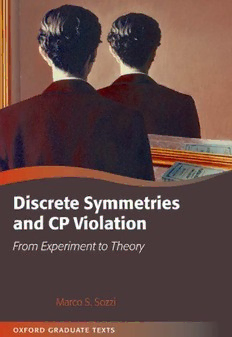Table Of ContentDiscrete Symmetries and CPViolation
This page intentionally left blank
Discrete Symmetries and
CP Violation
From Experiment to Theory
M. S. Sozzi
University of Pisa
1
3
GreatClarendonStreet,Oxfordox26dp
OxfordUniversityPressisadepartmentoftheUniversityofOxford.
ItfurtherstheUniversity’sobjectiveofexcellenceinresearch,scholarship,
andeducationbypublishingworldwidein
Oxford NewYork
Auckland CapeTown DaresSalaam HongKong Karachi
KualaLumpur Madrid Melbourne MexicoCity Nairobi
NewDelhi Shanghai Taipei Toronto
Withofficesin
Argentina Austria Brazil Chile CzechRepublic France Greece
Guatemala Hungary Italy Japan Poland Portugal Singapore
SouthKorea Switzerland Thailand Turkey Ukraine Vietnam
OxfordisaregisteredtrademarkofOxfordUniversityPress
intheUKandincertainothercountries
PublishedintheUnitedStates
byOxfordUniversityPressInc.,NewYork
©MarcoSozzi2008
Themoralrightsoftheauthorhavebeenasserted
DatabaserightOxfordUniversityPress(maker)
Firstpublished2008
Allrightsreserved.Nopartofthispublicationmaybereproduced,
storedinaretrievalsystem,ortransmitted,inanyformorbyanymeans,
withoutthepriorpermissioninwritingofOxfordUniversityPress,
orasexpresslypermittedbylaw,orundertermsagreedwiththeappropriate
reprographicsrightsorganization.Enquiriesconcerningreproduction
outsidethescopeoftheaboveshouldbesenttotheRightsDepartment,
OxfordUniversityPress,attheaddressabove
Youmustnotcirculatethisbookinanyotherbindingorcover
andyoumustimposethissameconditiononanyacquirer
BritishLibraryCataloguinginPublicationData
Dataavailable
LibraryofCongressCataloginginPublicationData
Sozzi,M.(Marco)
DiscretesymmetriesandCPviolation:fromexperimenttotheory/M.S.Sozzi.
p.cm.
ISBN978–0–19–929666–8
1.CPviolation(Nuclearphysics) 2.Symmetry(Physics) 3.Mirrorsymmetry.
I.Title.
QC793.3.V5S592007
(cid:1)
539.725—dc22 2007034660
TypesetbyNewgenImagingSystems(P)Ltd.,Chennai,India
PrintedinGreatBritain
onacidfreepaperby
BiddlesLtd.,King’sLynn,Norfolk
ISBN 978–0–19–929666–8
AEdoardo:luce.
This page intentionally left blank
PREFACE
AsfarasIsee,
allaprioristatementsinphysics
havetheirorigininsymmetry.
H.Weyl
Thisworkoriginatesfromtheconstructiveinterferenceofseveralconsiderations.
As usual, lecture notes for courses given over several years to undergraduate
andgraduatestudentswerethestartingpoint.InteachingthebasicsofCPviolation
I tried to put some emphasis on ‘how’our current knowledge was obtained, and
‘why’thingsweredoneastheywere;intheprocessIfoundthatnoneoftheseveral
very good books on the subject provided to the student all the aspects I felt to be
important.
First, as the subject is not an easy one, sometimes students struggling to find
theirwayamongthemyriadofphasesandamplitudesmightbeleftwiththefeeling
that eventually everything is so nicely ‘explained’within the Standard Model of
Particle Physics (SM in the following) that no other possibility could actually
be conceived: the ‘poor researchers’ of times past just didn’t have a chance to
understand what is now clear and pristine. While this is clearly a naive and non-
historical view, my objection is mostly to the fact that it tends to dim the critical
attitude of the student – a danger to which all researchers are exposed from the
great successes of the Standard Model – and which must be resisted for progress
tooccur.Ifeelthatwhilelearningasubjectitisimportanttokeepabroaderview
initially, to pick connections and analogies with known phenomena; I have often
encountered young graduate students, very deeply into the details of their Ph.D.
workonsomeCP-violatingeffect,lackingasolidgraspofthebasicconnectionwith
their neighbour’s work. Older textbooks often presented (quite understandably) a
broader treatment of the basics; such books are however long out of print and of
coursehopelesslyoutdatedinmostoftheircontents.
Second,manytextbookslackanyemphasisontheexperimentsfromwhichour
understanding emerged (which can be partially excused when trying to keep the
size of a comprehensive book below the 1,000- page mark). Still, to understand
how ‘the numbers’are obtained, why some of them are easy to get and some are
not,whythingsaremeasuredinonewayratherthananother,orwhatdistinguishes
a successful experiment from another one, is a fundamental part of the formation
of any physicist, and several of my experimental colleagues would agree that too
oftenthisisthemostdifficulttoconvey.Again,youngworkersinthefield(notonly
viii PREFACE
thosewithhightheoreticalinclinations)sometimesgetthefeelingthatinorderto
make progress what is needed is just a brilliant theory, and then somebody has to
gooutandmeasureallitsparameterstocheckit.Ithinkathoroughappreciationof
the experimental principles is really crucial for any new generation of physicists,
evenmoresoatthepresenttimeinwhichexperiments(atleastinwhatwenowcall
high-energyphysics)areevolvingtowardslife-longenterprises:itisnotuncommon
nowadaystohaveayoungexperimentalphysiciststartingworkonaspecificissue
(be it an instrumentation, a simulation or a physics analysis topic) and be stuck
withthatformanyyears,withoutevergettingachancetolearntheprinciplesfor
designing a new experiment, which might be asked from her or him sometime in
thefuture.
Also,theappreciationofhowscientificprogressandtechnologicaladvancesare
deeplyintertwinedinbothdirectionsissomethingwhoseimportancetranscendsthe
formationofaphysicist.AsV.L.Fitch,oneoftheprotagonistsofthediscoveries
discussed in this work, puts it: ‘What always paces the rate of discovery is the
developmentofnewinstruments–newdevicesforprobingphenomena,eitherwith
anewlevelofprecisionorbyextendingtherangeofobservationintorealmsnever
beforeexplored’.AndalreadytwocenturiesagoSirH.Davystated:‘Nothingtends
somuchtotheadvancementofknowledgeastheapplicationofanewinstrument.
Thenativeintellectualpowersofmenindifferenttimesarenotsomuchthecauses
of the different success of their labours, as the peculiar nature of the means and
artificialresourcesintheirpossession’(Davy,1839).
Alltheabovewouldnothavebeenasufficientreasonformetowriteanewbook;
whatreallygotthisstartedwasthefeelingthattoomanystudentsdonotgetexposed
to the challenging aspects of experimental physics: if a smart student chooses to
pursueacareerintheoreticalphysicsthismustnotbebecauseshe/hewasnotgiven
achancetoappreciatehowdeep,beautifulandhighlystimulatingtheexperimental
endeavourcanbe.TheabovepointwasbestexpressedbyV.Telegdiinaniceshort
essay(Telegdi,1990),inwhichheremarkedhowthereisoftenasmuchintellectual
contentinanexperimentasinitstheoreticalinterpretation;heconcludedthat‘we
mustteachcoursesinwhichbrilliantexperimentsofgreatsignificanceareanalyzed
insomedetail’.
Now, the experimental investigation of tiny symmetry violations in physics is
reallyafieldwhichisfullofchallengingandcarefulexperiments,oftenwithalong
history of improvements and dedication; it encompasses many different branches
of physics and even more vastly different approaches; finally, it is a very active
field, with several new fundamental results being obtained in the past few years.
It appears to the author as an ideal subject to convey the depth and excitement of
experimentalphysics.
The patient reader can now appreciate the ideas behind the conception of this
book:whileitwouldbehighlypretentiousoftheauthortothinkofaddressingall
PREFACE ix
theaboveissueswithhiswork,hehopesthatthismodestattemptcanbeseenasa
stepinthedirectionsdiscussedabove,andthattherelevanceoftheimportantgoals
willthrowsomelightontheinevitableshortcomingsoftheactualresult.
ThebookdealsmostlywiththeC,P,T discretesymmetries:otherdiscretesymme-
triessuchastranslationalsymmetryincrystalsareoutsideitsscope.Whiletrying
tobeself-contained,itattemptstotakeasomewhatnovelapproachtothesubject:
moreemphasisthanusualisputonexperimentalaspects,tryingtoprovideasome-
what wider picture at the expense of some depth, and to convey the intellectual
challenge of the connection between phenomenology and experiment. Excellent
research-level books exist for the interested reader to dig more details on specific
topics, and the rather extensive bibliography provided might be helpful for this
purpose.
Inmostchapterssomerelevantexperimentsarediscussedinsomedetail,trying
toprovidetheaveragereadermoreinsightthanisobtainedjustbyreadingtheorigi-
nalpaper,oftenwrittenforexpertswellversedintheapproachesandresearchissues
ofthetime.Thefocusisnotsomuchonthedetectiontechniques(whichgrowold)
as on the experimental approaches (which do not). The choice of experiments is
tosomeextentarbitrary:itdidn’talwaysfallonthefirstexperimenttoobservean
effect,noronthelastorthemostprecise,butoftenononewhichwasfelttowell
exemplify some experimental issue. Many more beautiful and successful experi-
mentswouldhavedeservedtobediscussedindetail,butthiswouldhaverequired
several volumes (and several authors too).Also, while the most recent values for
experimental measurements are listed, many of them will grow old quickly, and
the most up-to-date figures should clearly be looked for in the appropriate place
(Yaoetal.,2006).
Asanexperimentalist,Icannotdofulljusticetothebeautyoftheoryand,need-
less to say, the balance of topics is due to a personal judgement of their relative
importanceandaffectedbymyownresearchactivityinhigh-energyphysics:read-
erswhoareexpertsinsomefieldmightwanttoskipthebasicexplanationofsome
techniqueswhicharewellknowntothem.Also,thebalanceissomewhatinfavour
of more ‘established’ physics issues, with more recent studies still under active
investigation(forwhichtheoverallpictureisstillinthemaking,andtheappraisal
of the relevance of individual measurements still lacks the benefit of time) being
discussedatamoreshallowlevel.
The level of the book was originally intended to be as accessible as possible,
andifthisgoalwasnotfullyachievedtheauthorisinexcellentcompany,asOkun’s
masterful(butprettyhardforanovice)work(Okun,1982)wasstartedwiththepur-
poseofbeing‘readableeveninatownbus’.Thetargetaudienceareundergraduate
and graduate students in physics; young researchers working in particle physics
and interested in getting a somewhat wider picture on topics related to their own
might also find this work of some interest.Ageneric undergraduate background

